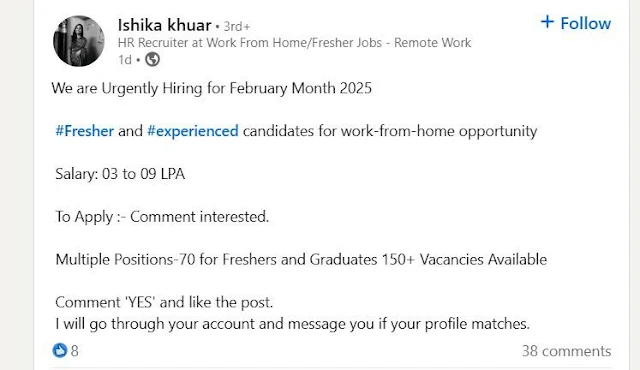Featured Post
Is LinkedIn Actually Cringey?
- Get link
- X
- Other Apps
Oh boy, LinkedIn. We've all been there, right? Scrolling through our feeds, seeing posts that make us pause and think, "Did I really just read that?" It's the platform for professionals, the place where we're supposed to put our best foot forward and network our way to success.
 |
| Source: Pixabay |
But lately, there's been a whisper, a growing feeling that maybe, just maybe, LinkedIn has a bit of a cringe problem. I mean, I try to keep it professional, share some positive vibes and interesting articles, and connect with my actual colleagues.
But after seeing what's out there, I've had to ask myself, have I been contributing to the cringe? Even the job search part, which is supposed to be a main feature, feels like a chaotic mess with endless competition and sketchy listings. It makes you wonder what's really going on.
The Rise of the LinkedIn Cringe
So, where does all this cringe come from? Based on what I've seen and read, it seems to stem from a few key areas. One major factor is the pressure people feel to perform and present a perfect, often exaggerated, version of their professional lives.
This leads to what many call "humblebrags" – those posts where someone talks about an achievement but tries to play it cool, making it even more obvious they're trying to impress. It's like saying, "Oh, this little project I casually worked on just happened to break all sales records, no big deal." We see this kind of thing talked about a lot; it's a common theme.
People feel the need to constantly share their successes, even minor ones, in a way that can come across as insincere or attention-seeking. It's like they're trying too hard to prove how successful they are, which can have the opposite effect.
Want to go beyond the blog? Subscribe to "A Little Bit More of Me" on Substack for exclusive content, deeper dives, and a closer look at my life and learnings.
Inauthenticity and Superficial Connections
Another reason for the cringe is the feeling of inauthenticity that can fill the platform. If you've been on LinkedIn for a bit, you've likely seen the overly motivational posts that feel hollow, the generic "thoughts?" comments on everything, and the long, dramatic personal stories that seem a bit too perfect to be entirely real.
It sometimes feels like everyone is putting on a show, trying to project an image of constant success and profound insight, even when their day-to-day might be totally different. This can make finding genuine interactions harder.
When connections feel forced or purely transactional – like someone only connecting to immediately try and sell you something – it takes away from the idea of real professional networking and building a community. It's less about building relationships over time and more about boosting visibility through sometimes awkward or irrelevant content.
 |
| Source: Pleated Jeans |
The Problem with "Thought Leaders" and Engagement Bait
Speaking of content, the rise of the self-proclaimed "thought leader" can also contribute to the cringe. These are the people who post lengthy, often vague, opinions on business trends or life lessons. Sometimes, they don't seem to have a ton of real, hands-on experience to back up their big statements.
Their goal seems to be more about getting likes and comments and looking important than actually offering valuable insights or starting a real conversation. This ties into "engagement bait," where users post things designed purely to get a reaction or game the algorithm, like asking overly simple questions or sharing polarizing statements just to stir things up.
This kind of content can really clutter the feed with noise and makes it harder to find worthwhile articles or genuine professional discussions. It's frustrating when your feed is full of posts that feel like clickbait dressed up in business casual.
 |
| Source: Pleated Jeans |
Job Searching Struggles and Fake Listings
My own experience, and that of many others, with job searching on LinkedIn aligns with another major source of frustration and, yes, cringe: the job listings themselves. It's supposed to be a primary tool for finding work, but it can be incredibly frustrating and feel like a waste of time sometimes.
There's a huge amount of competition, which is to be expected to some extent when you're looking for a job. But the issue of spam and fake job postings makes it even worse and adds a layer of suspicion to the whole process.
Articles and discussions online highlight that a significant percentage of job listings might not even be real job openings. These fake listings aren't just annoying; they can be used for data mining, phishing scams to steal your information, or simply by companies trying to make themselves look bigger or more active than they are by posting jobs that don't exist.
Spotting the red flags – vague job descriptions, requests for personal information too early in the process, or unprofessional communication from the "recruiter" – becomes a necessary but annoying part of the process. It makes the job search feel like navigating a minefield, and nobody needs that stress when they're trying to find their next opportunity.
 |
| Source: Reddit |
Identifying Fake Job Postings
It's super important to be cautious when you're looking for jobs on LinkedIn. Some clear signs that a job posting might be fake include really vague language that doesn't explain what you'd actually do, requests for sensitive personal information like your social security number or bank details upfront, or being asked to pay for things like equipment or training before you even start the job.
Legitimate companies usually have detailed job descriptions that explain the role and responsibilities clearly, and they absolutely do not ask for payment from applicants to get a job. Always do a little digging: research the company online and the person who contacted you.
Check if the job you're interested in is also listed on the company's official website under their careers section. If you can't find it there, that's a big red flag. If something about the job offer or the person contacting you feels off in any way, trust your gut. It's always better to be safe and just avoid engaging further. Protecting your personal information is key.
Using LinkedIn for Good, Not Just Cringe
Okay, so we've talked a lot about the cringe. But can you actually use LinkedIn effectively without falling into those traps or getting annoyed by others who do? Yes, I think you can. It's all about being intentional with how you use the platform.
Tips for a Less Cringey LinkedIn Experience
First off, focus on connecting with people you genuinely know or have a real reason to connect with. Think former colleagues, classmates, people you met at a networking event, or people in your industry whose work you admire. Sending personalized connection requests explaining why you want to connect goes a long way instead of using the generic invite.
When it comes to posting, think about sharing things that are truly valuable or interesting to your network. This could be insights from your work, helpful articles you've read, or thoughtful questions to start a real discussion. Avoid the overly dramatic personal stories unless they have a very clear and relevant professional lesson, and even then, keep it focused and authentic.
Be mindful of the "humblebrag" trap. It's okay to share your accomplishments, but try to do it in a way that's factual and focused on the achievement itself or the team effort, rather than just drawing attention to yourself in an over-the-top way.
 |
| Source: Inc. |
Engage with others' content thoughtfully. Instead of just typing "Great post!" try to add a comment that shows you actually read it and have something specific to say about it. This leads to more meaningful interactions and helps build real connections.
Clean up your own profile. Make sure your photo is professional, your headline is clear about what you do, and your summary highlights your skills and experience in a straightforward way. An incomplete or unprofessional profile can also contribute to the cringe factor.
And finally, manage your feed. LinkedIn lets you unfollow people without disconnecting from them. If someone consistently posts cringey or irrelevant content, just unfollow them. You'll still be connected, but you won't have to see their posts filling up your feed. This can make your daily scroll a much more positive experience.
Finding Value in the Network
Despite the cringe we've talked about, LinkedIn still serves as a huge directory of professionals and companies. It can be a way to stay connected with colleagues, keep up with industry news, and discover potential opportunities, especially if you're smart about how you use it.
The key is to be mindful of how you use it and what you choose to engage with. By focusing on genuine connections, sharing valuable content, being aware of the common cringe traps, and being cautious with job listings, you can make LinkedIn a much more useful and less annoying tool for your professional life.
It's about finding a balance and using the platform in a way that feels authentic to you, rather than getting caught up in the pressure to perform for an audience. Ultimately, LinkedIn's value depends on how we, as users, choose to interact with it.
While the cringe is real and sometimes overwhelming, there are still opportunities for genuine connection and learning. By being aware of the pitfalls and focusing on meaningful interactions, we can hopefully make our own LinkedIn experience a little less cringey and a little more valuable. It's a work in progress, just like our careers.
Key Takeaways
🤷 Is LinkedIn cringey? Often, yes.🙄 Humble brags and inauthentic posts are common.
🎣 Watch out for engagement bait and vague "thought leadership."
⚠️ Fake job listings are a frustrating problem for jobseekers.
🛡️ Be vigilant and verify job postings before sharing personal info.
🧘 Find ways to use LinkedIn authentically and minimize your cringe exposure.
Subscribe for more❣️
Want to go beyond the blog? Subscribe to A Little Bit More of Me on Substack for exclusive content, deeper dives, and a closer look at my life and learnings.
- Get link
- X
- Other Apps




Comments
Post a Comment